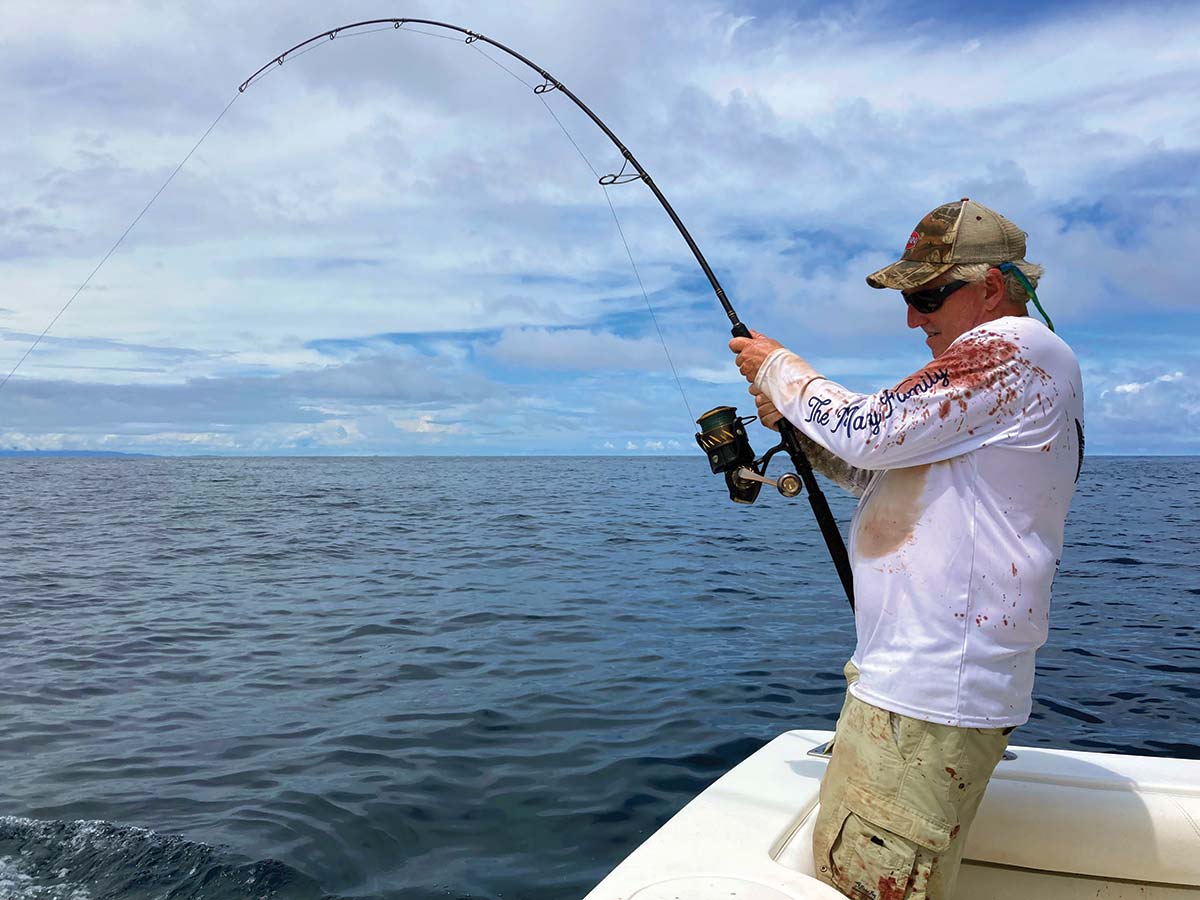
When it comes to midrange and offshore success, semper paratus is key!
It used to be that The Fisherman’s readers had to travel to 15- to 20-fathom waters to have either chance or intentional encounters with pelagic gamefish. With ocean waters exhibiting a gradual warming trend – combined with massive quantities of bunker schools and sand eels now inhabiting inshore waters – the hunters are venturing closer inshore to dine on their favorite forage. This creates opportunities for anglers closer to home port that a decade ago would have been described as a fantasy fish tale.
Like the scout’s motto, you need to “be prepared”!
As you read this, The Fisherman’s weekly catch report sections are replete with anglers hooking big sharks and bluefin tuna in the bunker schools, with occasional catches of cobia in estuary and inlet areas, plus dorado, yellowfin and other summer visitors in relatively near offshore waters.
And it’s only going to get better during the month of August, weather-permitting, as Gulfstream warm core eddy filaments meander inshore with even more pelagic visitors.
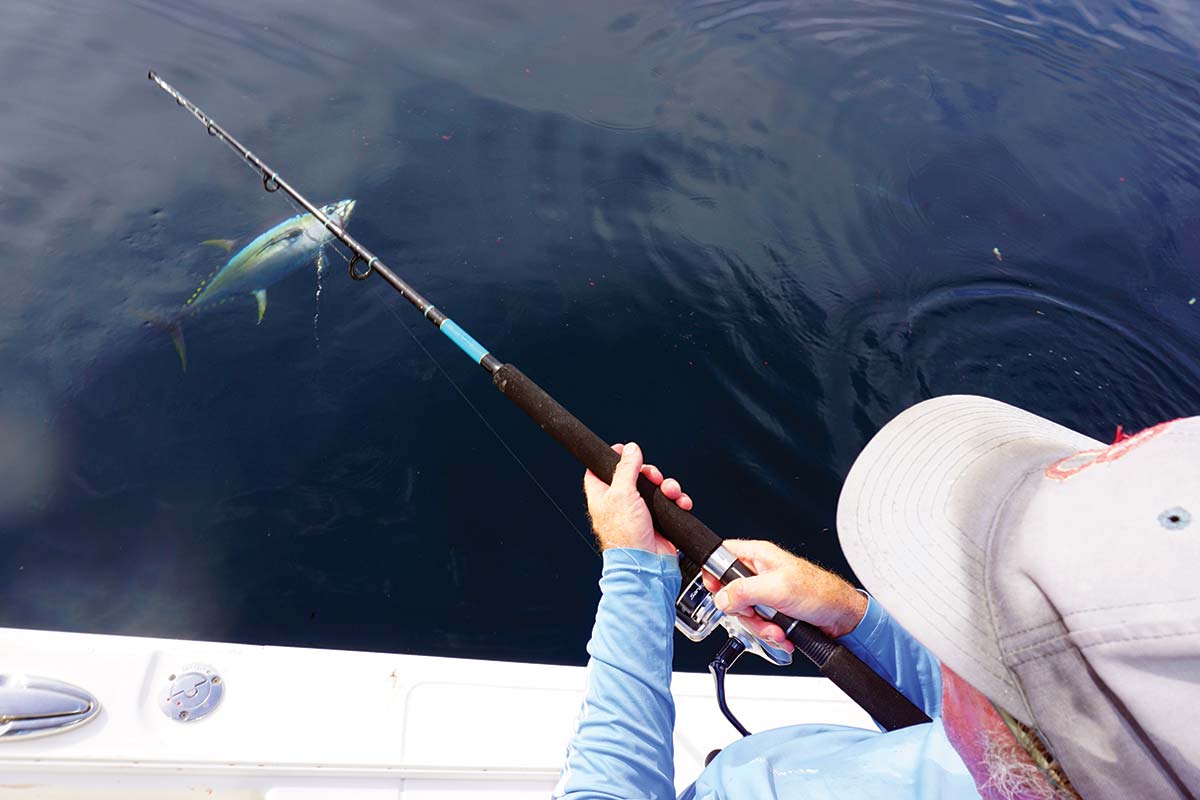
Always Prepared
As my Roman forbearers might say, semper paratus, which translates to “always prepared,” mirroring the Boy Scout motto of “be prepared” that I learned as a youth. This slogan aptly applies to the world of sportfishing and I have embraced the spirit of these words to always be ready for whatever opportunities the ocean provides, no matter how fleeting they might be.
I’ll usually have a few rods locked and loaded in the gunwales, leaning post or T-Top rocket launchers ready for immediate action should any opportunities present themselves. Part of the “always prepared” concept is to observe the ocean around you during your travels. Telling fish stories and catching up on old times with your buddies on the way to the grounds are all part of the sport fishing experience. But the boat’s operator should assign lookouts to monitor the port and starboard beams, not just for intersecting commercial boat traffic, but also for any signs that the pelagics which might be closer than you think.
If your boat has radar, set it in “bird mode” and look for telltale splotches of seagulls, terns or shearwaters on the screen that show up 2 to 4 miles ahead of or to the sides of the boat. Another trick that I’ve learned over the years is to put your boat’s echo sounder into wide-beam mode when underway and monitor signs of activity down under. This can be in the form of a large bait ball at mid-depths or pronounced red mounds or humps on the bottom in areas where you would expect to see a more flat terrain.
Leading indicators that the big game pelagic experience might be closer that you think can come in various olfactory forms. The most obvious of these is sight; if you see something, say something, even if it appears to be an optical illusion, apparition or mirage. This includes fins on the surface, free-jumping fish, congregating sea birds, oil slicks, bait sprays, floating trees, mats of Sargasso weeds, whale spouts, frolicking porpoises, lobster pot buoys and high-flyers, water color changes, working draggers or whatever.
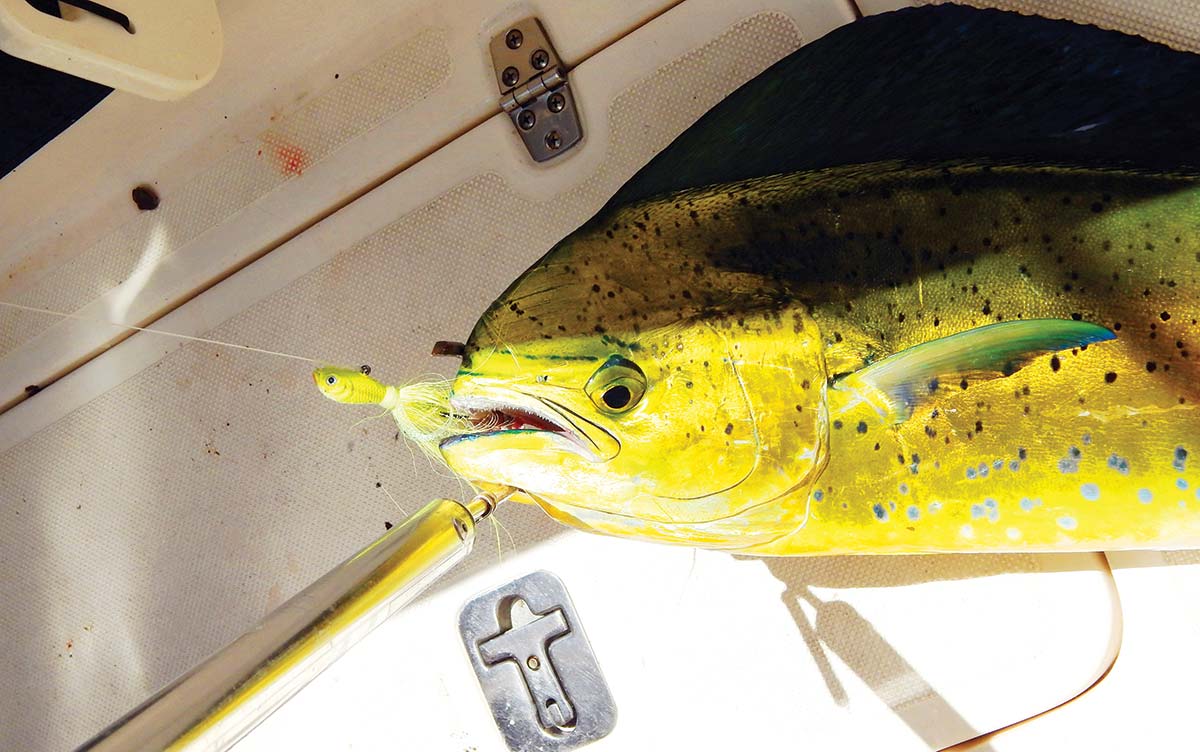
Another sense that can pay dividends is scent. You can frequently smell pelagics hammering terrified bait fish when you are downwind of whatever maritime melee is happening. If your nose picks up something that smells distinctly like watermelon or sweet chum, slowing down the boat and heading upwind can frequently lead you to the source, once again checking your echo sounder for intel down under, concentrated bird activity, or the surrounding surface areas for slicks or splashes.
Sound can also alert you that pelagics are in the area. Although it’s hard to hear unusual ocean surface noises when the boat is humming along at cruising speeds, when you are trolling or drifting, it’s a different deal. You can definitely hear a large pelagic, whale or porpoise pod making a commotion on the surface when trolling or drifting and then use your other senses to zone in on the source of the sound.
One sightcasting method that I’ll use is to try finding schools of yellowfin or bluefin near working draggers by trolling small squid spreader bars. We won’t deploy a complete trolling spread, but typically limit this effort to three to four bars coming off the rod tips, relatively close to the transom. Once we hook one up, we’ll clear the other rods and drop back a slow-pitch flutter jig or use a sub-surface swimmer like the Shimano Orca, Yo-Zuri Sinking Minnow or Hogy Slider in an attempt to lure some of the hooked tuna’s mates to the party. This method works often enough to give it a shot.
Yet another “sight fishing” technique is to have either live or cut bait all thawed out and ready to toss. To make this happen, it’s advisable to have the appropriate rod(s) ready for action in a rod holder or T-Top. Time is of the essence when seizing fleeting opportunities and every second you wait is a chance to lose the school that suddenly popped up without warning.
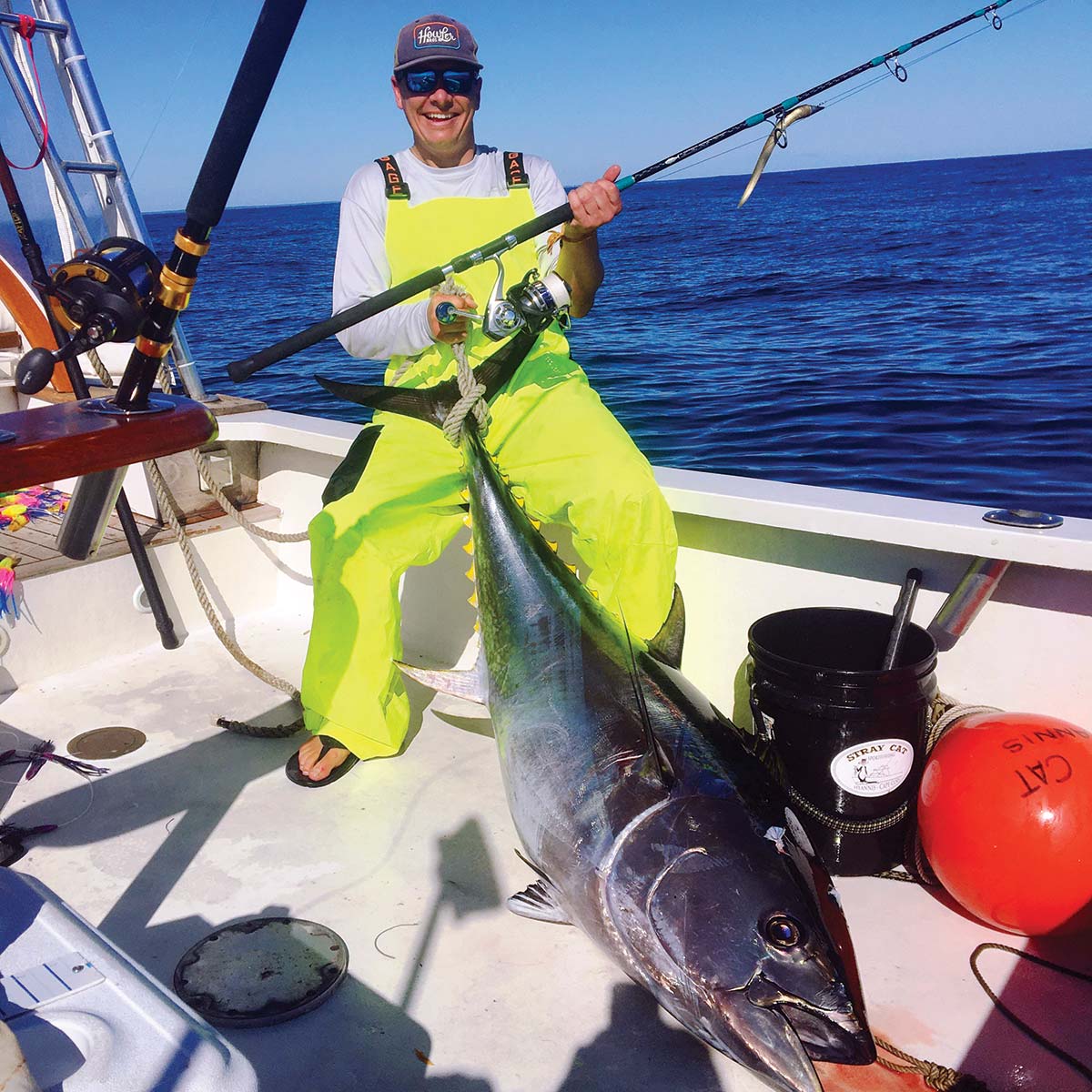
Tools For The Task
When it comes to near offshore and bluewater light-tackle angling for pelagics, I’m constantly changing and swapping out gear in an effort to stay at the tip of the technology spear. I will say something that is probably obvious to most of The Fisherman readers, but we are living in the dawn of a new era for bluewater-capable spinning gear. The next-gen reels from Shimano, Daiwa, PENN, Van Staal, Okuma and others can really get it done, as evidenced by the scores of giant bluefin tuna and other pelagic beasts that are consistently tamed by this light but powerful spin gear. Accordingly, my “semper paratus” outfits include but are not limited to the following quartet of rod and reel combos – the choice, description and application of each is not an absolute recommendation, it’s just something to get you thinking of what might work best for you in similar scenarios.
Shimano Stella 14000 spinning reel/Daiwa Saltiga 70HS jigging rod. This is my “big gun” casting outfit and these two components are a perfect match together. This 14000 series spinner may not the biggest fish in the Stella lineup, but it’s got plenty of drag power (55 pounds), is relatively lightweight (24.3 ounces), offers a 6.2:1 gear ratio that will retrieve 53 inches of line with every crank of the handle and will hold 400-plus yards of 65-pound PowerPro Maxcuatro braid.
The Daiwa Saltiga 70HS jigging rod is the end-result of a quest that I’ve had going on for a few years to match up to the Stella 14000 that does everything I need, including casting and jigging, battling 100- to 200-pound pelagics to boatside in minimal timelines. This rod is rated for 65- to 120-pound braid and can handle lures and jigs from 100 to 250 grams, which is roughly 3.5 to 9 ounces. The Fuji K-guides minimize dreaded wind knots and it features a composite rubber gimbal if you choose to use a fighting belt. At only 7 feet in length, it won’t win any long distance casting contests, but it’s compact enough to fit in my truck for away charters and it also minimizes any inadvertent contact with T-Tops, hardtops, outriggers and radio antennas when back-casting.
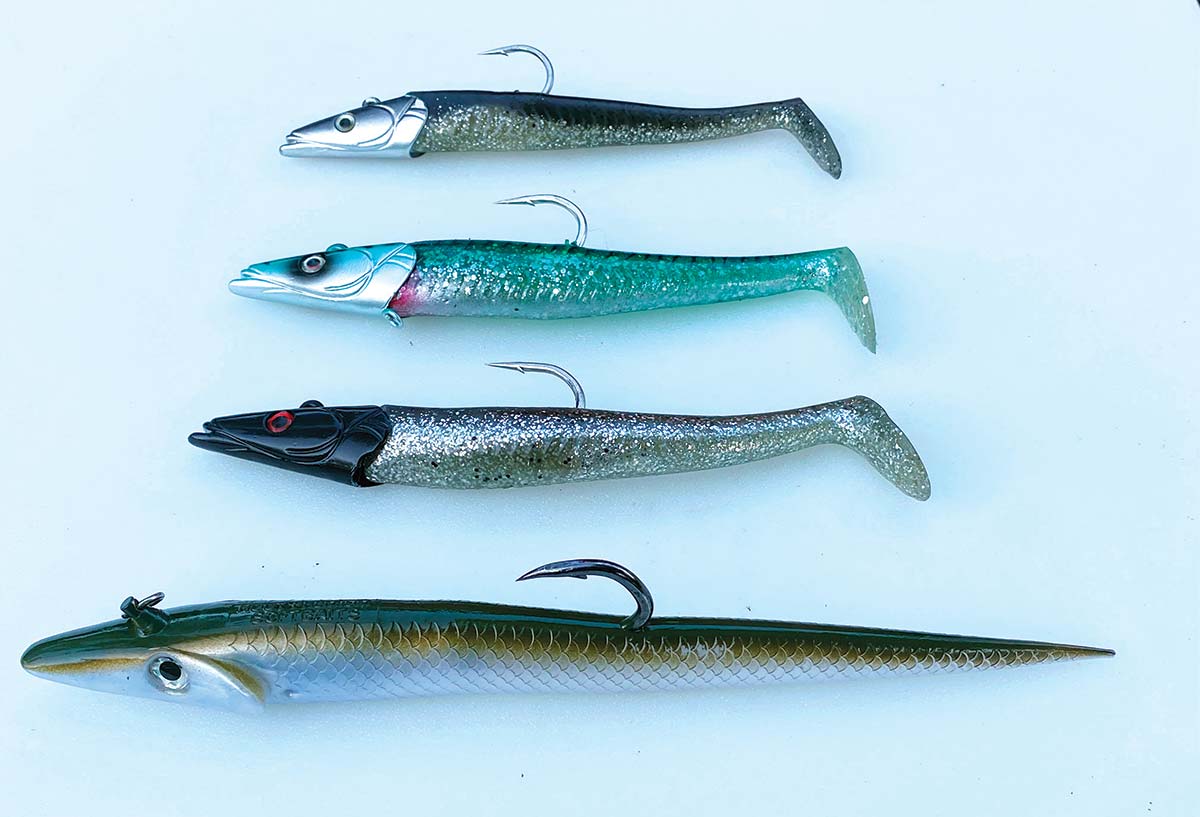
This particular rod will launch a 3- to 4-ounce popper or sub-surface swimming plug 50 to 60 yards away from the boat with relative ease and is also great for jigging tuna on the bottom, with a generous sweeping action. The shorter length will be a plus when trying to work a big fish around the crowded cockpit and for end game ceremonies. I’ll typically attach a tuna-sized Yo-Zuri popper or a Shimano SP Orca Flash Boost lure to this outfit for surface or sub-surface opportunities.
PENN Battle III DX reel/PENN Carnage II CARBII3065S70 rod. The PENN Battle III DX (dealer exclusive) is a relatively affordable spinner that features heavy duty brass gears, a 5.6:1 retrieve ratio that cranks 41 inches of line with every turn of the handle, weighs only 20.4 ounces, holds 350-plus yards of 50-pound PowerPro Maxcuatro braid and can dial in a max of 25 pounds of drag. This mates perfectly to my PENN Carnage II, 7-foot, 30- to 65-pound round, whose Fuji K-guides will ensure maximum casting distance. This rod offers a metal gimbal in the butt section if you prefer using a fighting belt. This is my dedicated heavy-duty ocean bunker snagging outfit and it is rigged accordingly with a large weighted treble hook, but can quickly transition to tossing a jig or a surface plug if the situation requires.
PENN International 12VISX two-speed lever drag reel/PENN Ally ALLBW2050C66 rod. One of the secrets to my big game/light tackle success over the years was the early adoption of PENN’s unique VSX series of two-speed lever drag reels (30, 20 and 16). These reels have consistently brought some whopper pelagics of all types to boatside, both in my boat and also on away charters. The VISX 12 is the latest addition to my lightweight VSX arsenal, weighing a relatively modest 32 ounces and offering both 5.1:1 and a 1.8:1 retrieve ratios with the ability to get 24 pounds of strike drag with a max drag of 40 pounds. I spooled this with 500-plus yards of PowerPro Maxcuatro braid and this mighty-mite reel definitely punches above it weight class. The low gear ratio can really move a stubborn pelagic off the bottom and get it coming up to the surface.
The one-piece PENN Ally rod was a nice starting point, but I cut off the tip to the first guide and added an oversized AFTCO roller tip to it to minimize line friction. The rod now measures about 6 feet, 2 inches and is my go-to tuna jigging rod when pelagics are either at mid-depths or hammering sand eels on the bottom in up to 35 fathoms of water. This rod offers an extended foregrip, plus a metal gimbal on the butt and with its hard Slickbutt lower section, it can double as a trolling rod in the spread if needed. I’ll usually attach either a soft sand eel jig (like a Savage sandeel, Hogy Pro Tail, RonZ) or a metal sand eel jig (Hogy, Tsunami, SPRO, etc.) to it and be ready to send it down to the bottom in a split second.
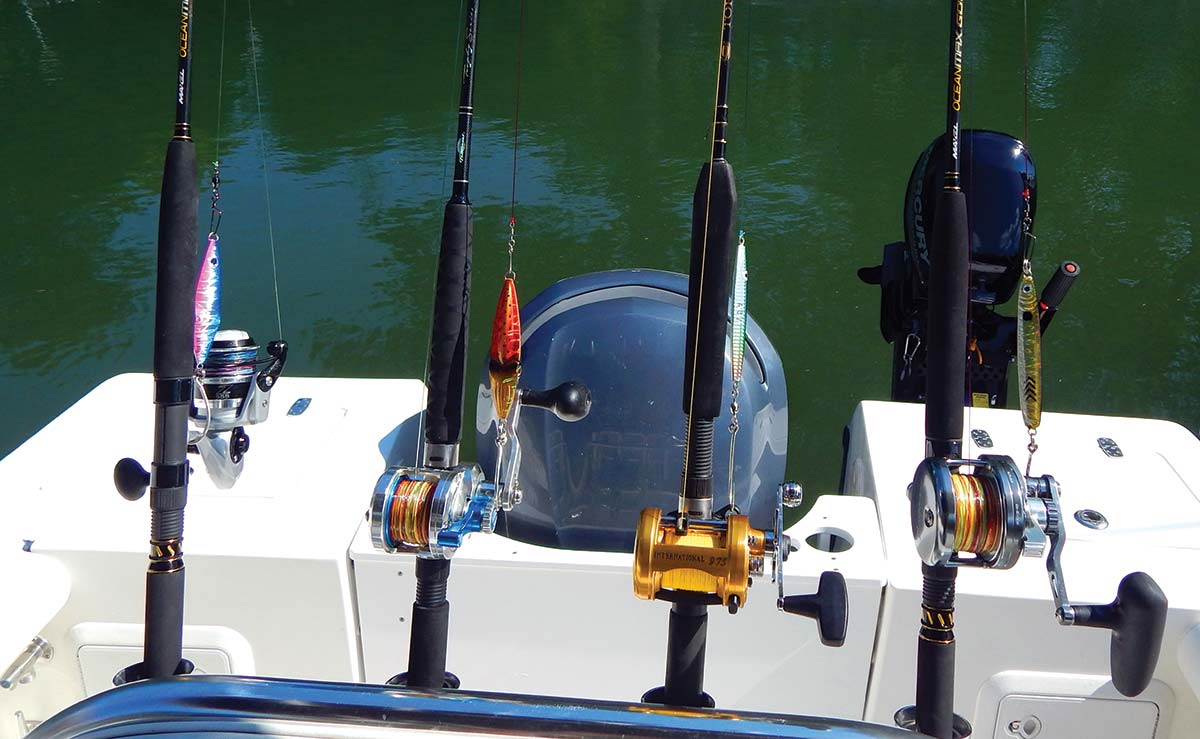
PENN Battle III 4000 DX reel/Tsunami Sapphire SABSXTP-631M rod. This is my deepwater snap-jigging outfit and consists of the PENN Battle III 4000 DX reel with upgraded brass gears, a capacity of 275 yards of 20-pound TUF-Line 4orce braid, a retrieve ratio of 6.2:1, a light weight of only 12.2 ounces with a max drag rating of 15 pounds. This reel has also tamed many a dorado hanging around the lobster pots, both in 40 fathoms and at the canyon.
The Tsunami Sapphire rod is a real winner, relatively affordable, is tough as nails, can handle lures and jigs from 3/4 to 4 ounces. With an overall length of 6 feet, 3 inches, it’s the perfect size for travelling in my truck, stowing in a rocket launcher until needed and is not a collision hazard for overhead impediments when casting from a small boat or cramped cockpit. My go-to lure for casting to surface targets is a pink SPRO 1-1/2-ounce bucktail. This one lure has taken over a thousand pounds of dorado through the years and is a proven performer. For bottom-dropping, I’ll switch over to a 2- to 3-ounce fast-sinking jig, depending on the depth and current. Braid Slammer jigs, Shimano Coltsnipers and Hogy sandeel jigs have worked very consistently for me in this fishery.
Whatever rods that you choose for your sightcasting duties should be rigged and ready to go, lures connected and available for immediate deployment. You should also designate specific members of the crew to be responsible for using these outfits when any opportunity presents itself. Remember, “semper paratus”!




